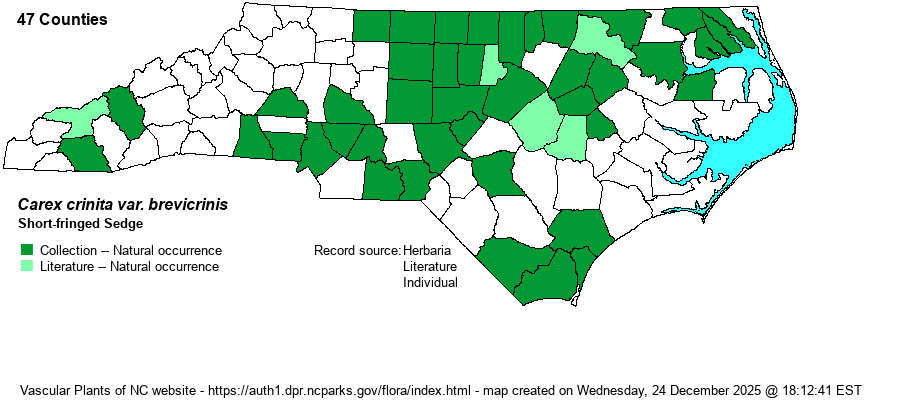| Author | Fernald | |
| Distribution | Mostly Piedmont and northern Coastal Plain; rare in Mountains and Sandhills proper, uncommon in southern Coastal Plain.
MA to OH and KY, south to GA and TX; inland to OK, MO, and NE. | |
| Abundance | Frequent in the Piedmont, rare in Mountains and Sandhills proper, uncommon in southern Coastal Plain. Populations may number in the hundreds of plants, as at floodplain pools at White Pines Preserve in Chatham County. | |
| Habitat | As with var. crinita, a wide variety of wetland habitats. At White Pines Preserve, Chatham County, it is common in floodplain pools. Interestingly, it rarely (as far as known) shares the same sites as var. crinita. | |
| Phenology | Flowering and fruiting late April-August. | |
| Identification | Short-fringed Sedge is readily separated from var. crinita by smooth achenes, lacking a constriction or a groove in the side. Separated from C. mitchelliana and C. gynandra by glabrous leaf sheaths (vs. scabrous) and retuse tips of female scales (vs. truncate to acuminate). | |
| Taxonomic Comments | This taxon has in the past not been recognized at any level; however, it is supported by recent genetic and morphological data.
The genus Carex is the largest in North America, and among the largest in the world. In temperate and boreal regions, Carex is often the dominant or co-dominant ground layer in many habitats. Seeds (achenes) are valuable food for birds and small mammals, while foliage is used by birds and mammals to make nests and as food by mammals. Species of Carex often look vastly different from one another -- spikes erect vs. drooping, tiny inflorescence vs. whopping, culms leafy vs. naked, perigynia beaked vs. beakless, stems densely bunched vs. single, etc. The genus has been divided into many sections (or groups), based on shared characters; some taxonomists have suggested that these be different genera, but that proves unworkable (so far). All Carex share the feature of a perigynium (an outer covering) which completely surrounds the achene (seed). This covering may fit tightly or loosely (like a small bladder), depending on which group or species. Details of perigynia shape, ornamentation, presence and size of beak, number of striations (or veins) are all important ID features. In recent years Rob Naczi and colleagues have stressed the importance of arrangement of perigynia -- whether spiral (3+ ranks) or distichous (2-ranked) -- and have named a number of new species as well as split off some older synonyms. Therefore, RAB's (1968) key, excellent for its time, can only be used in a general way today. Members of some sections of Carex are difficult to key out (notably Ovales, Laxiflorae, Griseae); this is in part due to variation among individuals of a species, or failings of the key. FNA has drawings of most species and some species may be found in two or more places within a key, to acount for variability. New species to NC, and new to science(!), continue to be found in NC. | |
| Other Common Name(s) | | |
| State Rank | [S5?] | |
| Global Rank | G5T5 | |
| State Status | | |
| US Status | | |
| USACE-agcp | | |
| USACE-emp | | |

